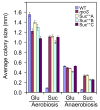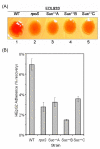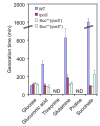Polymorphism and selection of rpoS in pathogenic Escherichia coli
- PMID: 19493358
- PMCID: PMC2700278
- DOI: 10.1186/1471-2180-9-118
Polymorphism and selection of rpoS in pathogenic Escherichia coli
Abstract
Background: Though RpoS is important for survival of pathogenic Escherichia coli in natural environments, polymorphism in the rpoS gene is common. However, the causes of this polymorphism and consequential physiological effects on gene expression in pathogenic strains are not fully understood.
Results: In this study, we found that growth on non-preferred carbon sources can efficiently select for loss of RpoS in seven of ten representative verocytotoxin-producing E. coli (VTEC) strains. Mutants (Suc++) forming large colonies on succinate were isolated at a frequency of 10-8 mutants per cell plated. Strain O157:H7 EDL933 yielded mainly mutants (about 90%) that were impaired in catalase expression, suggesting the loss of RpoS function. As expected, inactivating mutations in rpoS sequence were identified in these mutants. Expression of two pathogenicity-related phenotypes, cell adherence and RDAR (red dry and rough) morphotype, were also attenuated, indicating positive control by RpoS. For the other Suc++ mutants (10%) that were catalase positive, no mutation in rpoS was detected.
Conclusion: The selection for loss of RpoS on poor carbon sources is also operant in most pathogenic strains, and thus is likely responsible for the occurrence of rpoS polymorphisms among E. coli isolates.
Figures





Similar articles
-
Global effect of RpoS on gene expression in pathogenic Escherichia coli O157:H7 strain EDL933.BMC Genomics. 2009 Aug 3;10:349. doi: 10.1186/1471-2164-10-349. BMC Genomics. 2009. PMID: 19650909 Free PMC article.
-
Phenotypic diversity caused by differential RpoS activity among environmental Escherichia coli isolates.Appl Environ Microbiol. 2011 Nov;77(22):7915-23. doi: 10.1128/AEM.05274-11. Epub 2011 Sep 23. Appl Environ Microbiol. 2011. PMID: 21948830 Free PMC article.
-
Impact of the rpoS genotype for acid resistance patterns of pathogenic and probiotic Escherichia coli.BMC Microbiol. 2007 Mar 26;7:21. doi: 10.1186/1471-2180-7-21. BMC Microbiol. 2007. PMID: 17386106 Free PMC article.
-
The Polymorphic Aggregative Phenotype of Shiga Toxin-Producing Escherichia coli O111 Depends on RpoS and Curli.Appl Environ Microbiol. 2015 Dec 28;82(5):1475-1485. doi: 10.1128/AEM.03935-15. Appl Environ Microbiol. 2015. PMID: 26712542 Free PMC article.
-
Characteristics of the Shiga-toxin-producing enteroaggregative Escherichia coli O104:H4 German outbreak strain and of STEC strains isolated in Spain.Int Microbiol. 2011 Sep;14(3):121-41. doi: 10.2436/20.1501.01.142. Int Microbiol. 2011. PMID: 22101411 Review.
Cited by
-
RpoS contributes in a host-dependent manner to Salmonella colonization of the leaf apoplast during plant disease.Front Microbiol. 2022 Nov 8;13:999183. doi: 10.3389/fmicb.2022.999183. eCollection 2022. Front Microbiol. 2022. PMID: 36425046 Free PMC article.
-
Role of RpoS in virulence of pathogens.Infect Immun. 2010 Mar;78(3):887-97. doi: 10.1128/IAI.00882-09. Epub 2009 Nov 30. Infect Immun. 2010. PMID: 19948835 Free PMC article. Review.
-
Adaptation and compensation in a bacterial gene regulatory network evolving under antibiotic selection.Elife. 2021 Sep 30;10:e70931. doi: 10.7554/eLife.70931. Elife. 2021. PMID: 34591012 Free PMC article.
-
Function, Evolution, and Composition of the RpoS Regulon in Escherichia coli.Front Microbiol. 2020 Sep 17;11:560099. doi: 10.3389/fmicb.2020.560099. eCollection 2020. Front Microbiol. 2020. PMID: 33042067 Free PMC article. Review.
-
Selection for loss of RpoS in Cronobacter sakazakii by growth in the presence of acetate as a carbon source.Appl Environ Microbiol. 2013 Mar;79(6):2099-102. doi: 10.1128/AEM.03302-12. Epub 2013 Jan 18. Appl Environ Microbiol. 2013. PMID: 23335773 Free PMC article.
References
-
- Stoodley P, Sauer K, Davies DG, Costerton JW. Biofilms as complex differentiated communities. Annu Rev Microbiol. 2002;56:187–209. - PubMed
-
- Davidson CJ, Surette MG. Individuality in bacteria. Annu Rev Genet. 2008;42:253–268. - PubMed
-
- Wolf DM, Vazirani VV, Arkin AP. Diversity in times of adversity: probabilistic strategies in microbial survival games. J Theor Biol. 2005;234:227–253. - PubMed
-
- Hallet B. Playing Dr Jekyll and Mr Hyde: combined mechanisms of phase variation in bacteria. Curr Opin Microbiol. 2001;4:570–581. - PubMed
Publication types
MeSH terms
Substances
LinkOut - more resources
Full Text Sources
Research Materials

